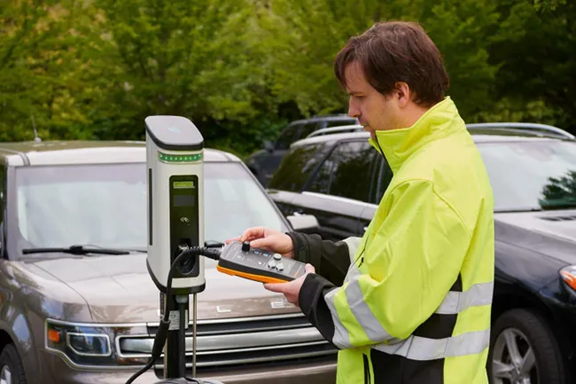As electric vehicles (EVs) continue to gain traction in the global automotive market, the infrastructure that supports their operation becomes increasingly important. One critical aspect of this infrastructure is Electric Vehicle Supply Equipment (EVSE), commonly known as EVSE chargers. In this article, we delve into the specifics of EVSE, exploring its components, how it works, and the different types of EVSE charging systems available.
 Using the Fluke FEV100 Electric Vehicle Charging Station EVSE Test Adapter on a parking lot charging station.
Using the Fluke FEV100 Electric Vehicle Charging Station EVSE Test Adapter on a parking lot charging station.What Is Electric Vehicle Supply Equipment?
Electric Vehicle Supply Equipment (EVSE) is the critical link that delivers power from an electricity source to an electric vehicle's battery. It's more commonly referred to as an electric vehicle charging station, EV charging station, or simply, an EV charger.
How Does an EVSE Charger Work?
The purpose of an EV charger is quite simple. It basically facilitates the conversion of alternating current (AC) from your power source into direct current (DC) to charge the vehicle's battery. The EV charger communicates with the vehicle to ensure that a safe and appropriate level of electricity is supplied. The charger's main function is to provide electrical safety for the user and the vehicle during the charging process.
What Are the Components of EVSE?
The EVSE comprises a few key components. First, there's the electric cable which connects the vehicle to the charging station. This cable is typically fitted with a specially designed plug for a secure and safe connection. The EVSE also includes a power input, which can be connected to your home or commercial electricity supply. Some EVSEs come with additional features like timers, meters, and Wi-Fi connectivity for remote monitoring and control.
How to Test an EVSE Charger
Testing an EVSE charger is crucial for ensuring the safety and efficiency of electric vehicle charging stations. A comprehensive testing process typically involves checking the charger's electrical connections, power output, and communication systems to ensure they are functioning correctly and safely.
Test tools like the Fluke FEV150 EV Charging Station Analyzer and the Fluke FEV100 EVSE Test Adapter play a vital role in this process by allowing technicians to connect professional test equipment to EV charging stations.
The FEV150 is an advanced all-in-one tool designed to make maintenance and troubleshooting more efficient and reliable. It’s designed for AC EV charging stations with Type 1 or Tesla-type connectors. The FEV150’s advanced diagnostics and detailed control pilot signal waveform analysis are invaluable for installation and maintenance tasks — especially in more complex, high-demand commercial and industrial applications.
The FEV100 EVSE Test Adapter is also essential for preventive maintenance. It simulates the control pilot charging state of an electric vehicle and automates several safety and functionality tests — without an EV required — which enables a single technician to test a charger in 10 to 15 minutes. The FEV100 is designed to work in conjunction with other test and measurement tools, such as digital multimeters or ScopeMeters, to facilitate advanced diagnostics.
These tools help technicians work quickly and reliably to ensure that the charging station is operating as intended and can safely charge electric vehicles, which helps to prevent any potential issues that could arise from faulty equipment.
How Do EV Chargers Get Power?
EV chargers can be connected to the electricity grid in a variety of ways, depending on their type and the level of charging they provide. Some can be plugged into a standard household electrical outlet, while others may require a dedicated circuit from the electrical panel due to their higher power demand. In some cases, EV chargers can also be powered by renewable energy sources like solar panels.
Does an EV Charger Draw Power When Not in Use?
Most EV chargers do not draw power when they are not actively charging a vehicle. However, some models might use a small amount of power to maintain their internal electronics, as do many other electronic devices. Always refer to your charger's user manual for specific information.
What Are the Three Types of EV Charging Systems?
There are three main types of EV charging systems: Level 1, Level 2, and DC Fast Charging (DCFC).
- Level 1 charging is the most basic and uses a standard household outlet. It is the slowest method but requires no additional equipment beyond what comes with the vehicle.
- Level 2 charging requires a dedicated 240-volt circuit and can charge an EV significantly faster. Most public charging stations are Level 2.
- DC Fast Charging, also known as Level 3, is the quickest method. It requires specialized high-powered equipment and can charge an EV to 80% in less than an hour. However, not all electric vehicles can handle this level of charging.
In conclusion, understanding EVSE is essential for electric vehicle owners and those contemplating making the switch from conventional vehicles. By understanding the different types of EV chargers available and how they work, users can make informed decisions about the best charging solutions for their needs.